Analysis of Sustainable Urban Development for UTS Building 15 Retrofit
VerifiedAdded on 2023/02/01
|12
|2898
|48
Report
AI Summary
This report delves into the principles of sustainable urban development, emphasizing the interconnectedness of economic, social, and environmental systems. It examines the concept of sustainable development, as defined by the Bruntland report, and its application in the context of urban environments. The report focuses on a retrofit proposal for Building 15 at the University of Technology Sydney (UTS), acting as a sustainability consultant. The proposal outlines short-term, medium-term, and long-term strategies, including green roofs, UV-reflective paint, solar PV panels, rainwater collection, and community participation programs. The goal is to enhance economic opportunities, community well-being, and environmental preservation, aligning with the UTS sustainability vision. The report details specific sustainability indicators and assumptions, presenting a comprehensive approach to creating a more sustainable urban environment through building retrofits and innovative design solutions.
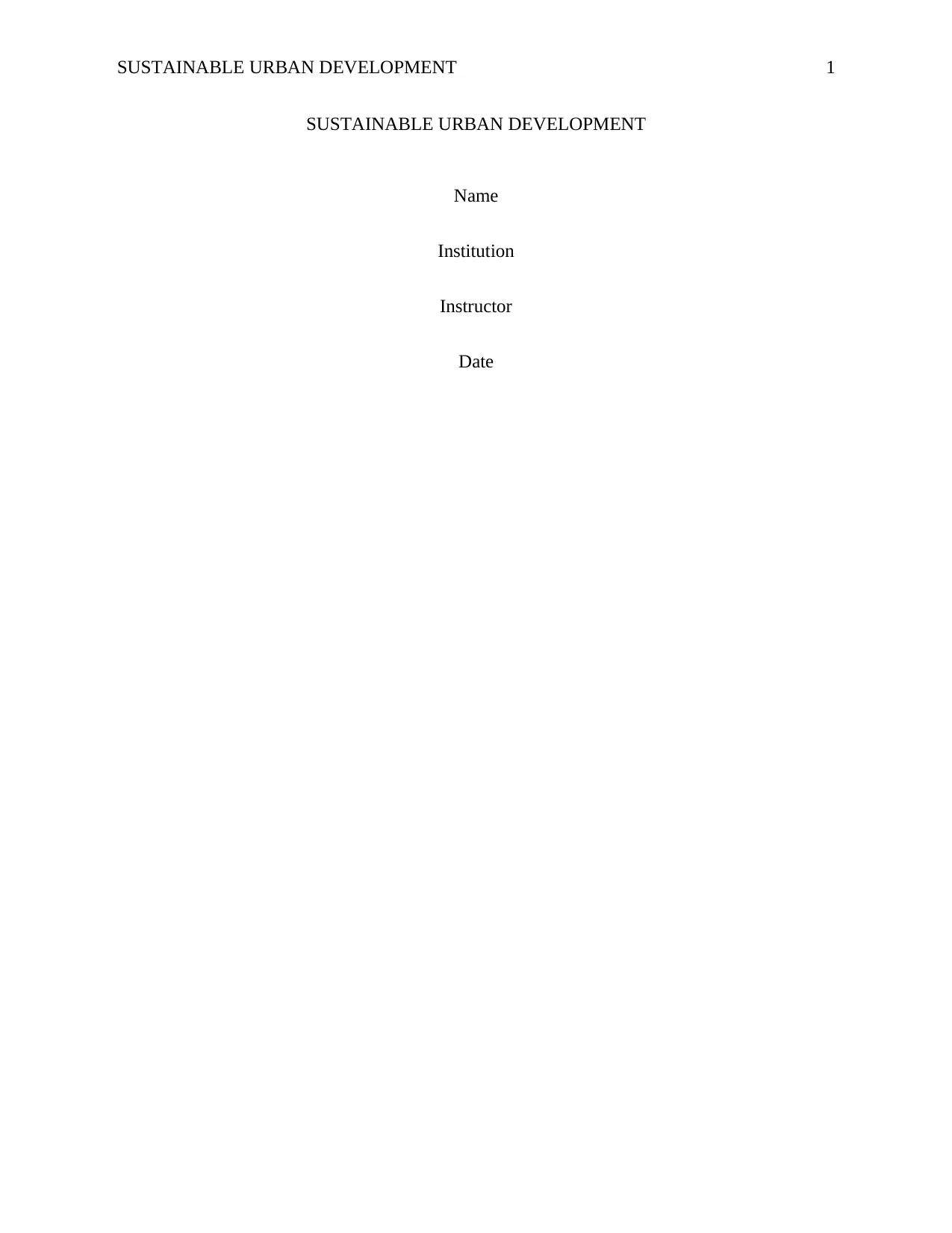
SUSTAINABLE URBAN DEVELOPMENT 1
SUSTAINABLE URBAN DEVELOPMENT
Name
Institution
Instructor
Date
SUSTAINABLE URBAN DEVELOPMENT
Name
Institution
Instructor
Date
Paraphrase This Document
Need a fresh take? Get an instant paraphrase of this document with our AI Paraphraser
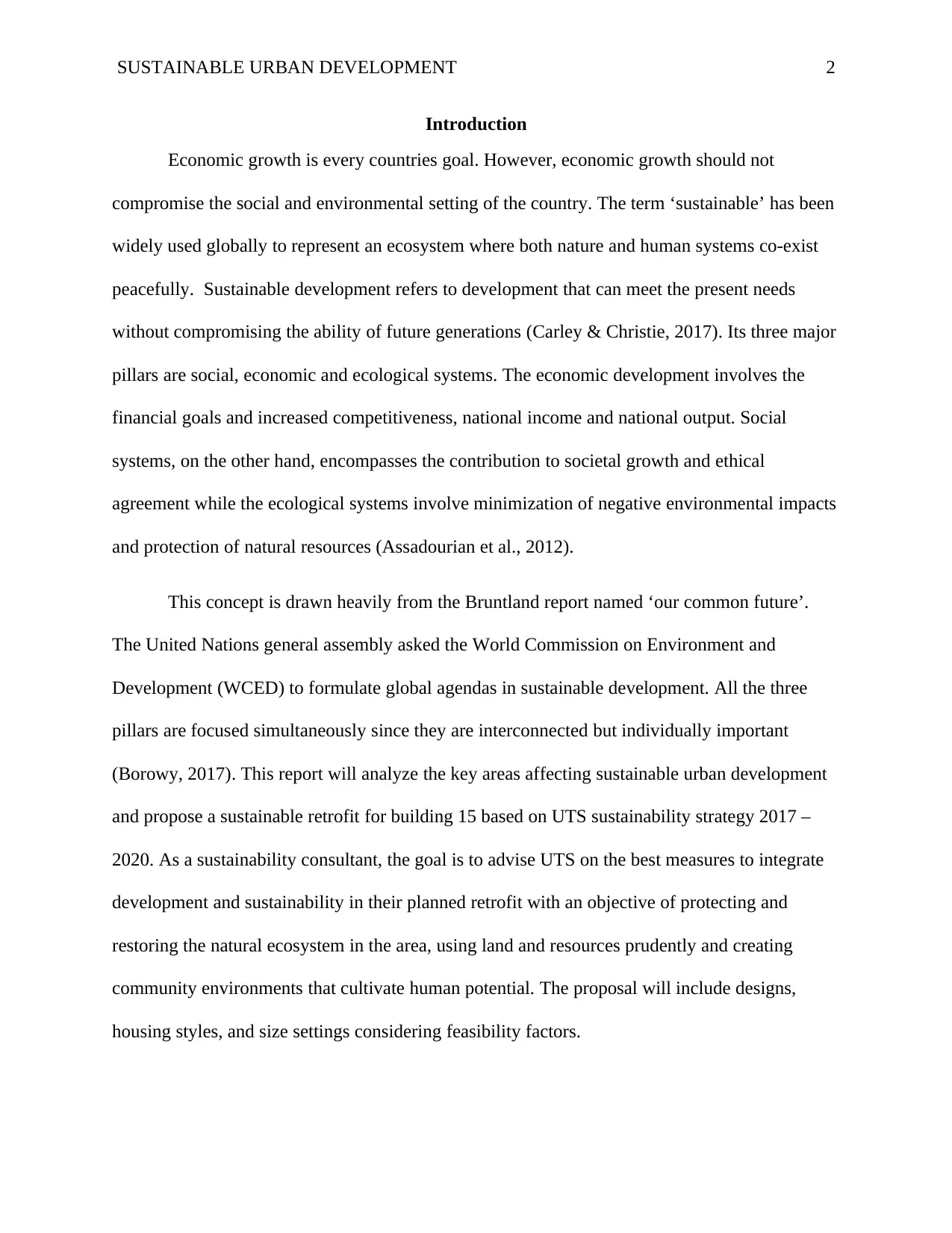
SUSTAINABLE URBAN DEVELOPMENT 2
Introduction
Economic growth is every countries goal. However, economic growth should not
compromise the social and environmental setting of the country. The term ‘sustainable’ has been
widely used globally to represent an ecosystem where both nature and human systems co-exist
peacefully. Sustainable development refers to development that can meet the present needs
without compromising the ability of future generations (Carley & Christie, 2017). Its three major
pillars are social, economic and ecological systems. The economic development involves the
financial goals and increased competitiveness, national income and national output. Social
systems, on the other hand, encompasses the contribution to societal growth and ethical
agreement while the ecological systems involve minimization of negative environmental impacts
and protection of natural resources (Assadourian et al., 2012).
This concept is drawn heavily from the Bruntland report named ‘our common future’.
The United Nations general assembly asked the World Commission on Environment and
Development (WCED) to formulate global agendas in sustainable development. All the three
pillars are focused simultaneously since they are interconnected but individually important
(Borowy, 2017). This report will analyze the key areas affecting sustainable urban development
and propose a sustainable retrofit for building 15 based on UTS sustainability strategy 2017 –
2020. As a sustainability consultant, the goal is to advise UTS on the best measures to integrate
development and sustainability in their planned retrofit with an objective of protecting and
restoring the natural ecosystem in the area, using land and resources prudently and creating
community environments that cultivate human potential. The proposal will include designs,
housing styles, and size settings considering feasibility factors.
Introduction
Economic growth is every countries goal. However, economic growth should not
compromise the social and environmental setting of the country. The term ‘sustainable’ has been
widely used globally to represent an ecosystem where both nature and human systems co-exist
peacefully. Sustainable development refers to development that can meet the present needs
without compromising the ability of future generations (Carley & Christie, 2017). Its three major
pillars are social, economic and ecological systems. The economic development involves the
financial goals and increased competitiveness, national income and national output. Social
systems, on the other hand, encompasses the contribution to societal growth and ethical
agreement while the ecological systems involve minimization of negative environmental impacts
and protection of natural resources (Assadourian et al., 2012).
This concept is drawn heavily from the Bruntland report named ‘our common future’.
The United Nations general assembly asked the World Commission on Environment and
Development (WCED) to formulate global agendas in sustainable development. All the three
pillars are focused simultaneously since they are interconnected but individually important
(Borowy, 2017). This report will analyze the key areas affecting sustainable urban development
and propose a sustainable retrofit for building 15 based on UTS sustainability strategy 2017 –
2020. As a sustainability consultant, the goal is to advise UTS on the best measures to integrate
development and sustainability in their planned retrofit with an objective of protecting and
restoring the natural ecosystem in the area, using land and resources prudently and creating
community environments that cultivate human potential. The proposal will include designs,
housing styles, and size settings considering feasibility factors.
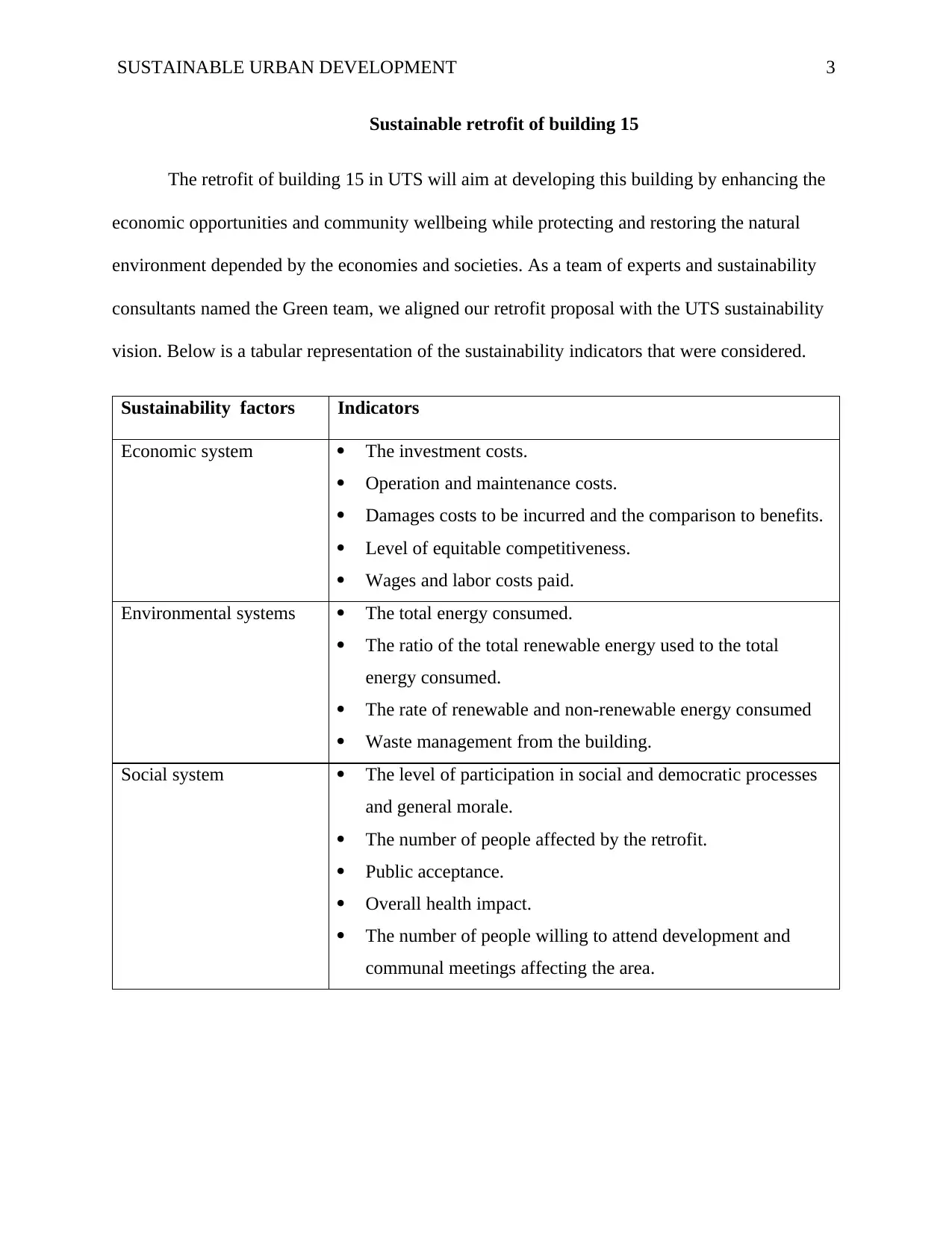
SUSTAINABLE URBAN DEVELOPMENT 3
Sustainable retrofit of building 15
The retrofit of building 15 in UTS will aim at developing this building by enhancing the
economic opportunities and community wellbeing while protecting and restoring the natural
environment depended by the economies and societies. As a team of experts and sustainability
consultants named the Green team, we aligned our retrofit proposal with the UTS sustainability
vision. Below is a tabular representation of the sustainability indicators that were considered.
Sustainability factors Indicators
Economic system The investment costs.
Operation and maintenance costs.
Damages costs to be incurred and the comparison to benefits.
Level of equitable competitiveness.
Wages and labor costs paid.
Environmental systems The total energy consumed.
The ratio of the total renewable energy used to the total
energy consumed.
The rate of renewable and non-renewable energy consumed
Waste management from the building.
Social system The level of participation in social and democratic processes
and general morale.
The number of people affected by the retrofit.
Public acceptance.
Overall health impact.
The number of people willing to attend development and
communal meetings affecting the area.
Sustainable retrofit of building 15
The retrofit of building 15 in UTS will aim at developing this building by enhancing the
economic opportunities and community wellbeing while protecting and restoring the natural
environment depended by the economies and societies. As a team of experts and sustainability
consultants named the Green team, we aligned our retrofit proposal with the UTS sustainability
vision. Below is a tabular representation of the sustainability indicators that were considered.
Sustainability factors Indicators
Economic system The investment costs.
Operation and maintenance costs.
Damages costs to be incurred and the comparison to benefits.
Level of equitable competitiveness.
Wages and labor costs paid.
Environmental systems The total energy consumed.
The ratio of the total renewable energy used to the total
energy consumed.
The rate of renewable and non-renewable energy consumed
Waste management from the building.
Social system The level of participation in social and democratic processes
and general morale.
The number of people affected by the retrofit.
Public acceptance.
Overall health impact.
The number of people willing to attend development and
communal meetings affecting the area.
⊘ This is a preview!⊘
Do you want full access?
Subscribe today to unlock all pages.

Trusted by 1+ million students worldwide
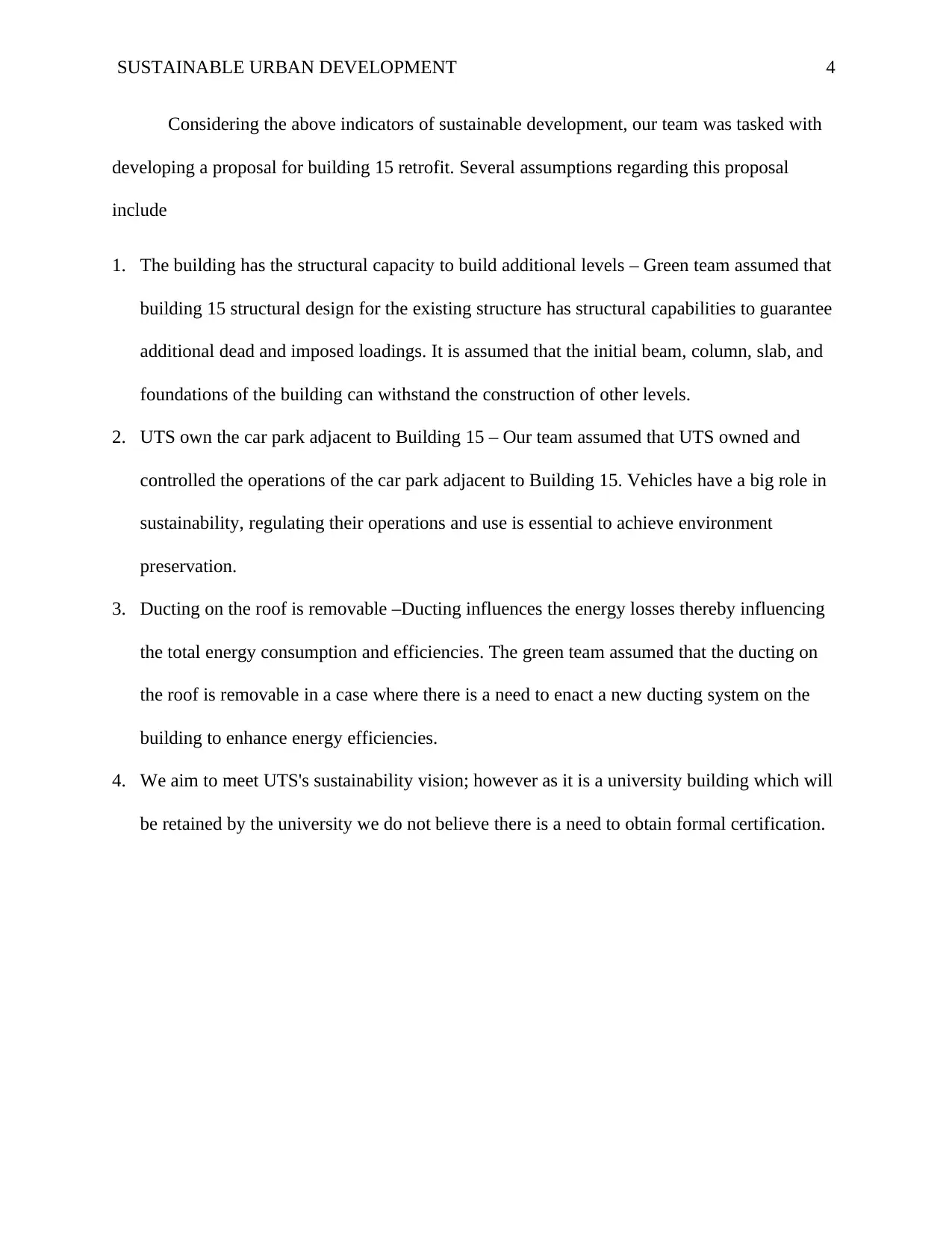
SUSTAINABLE URBAN DEVELOPMENT 4
Considering the above indicators of sustainable development, our team was tasked with
developing a proposal for building 15 retrofit. Several assumptions regarding this proposal
include
1. The building has the structural capacity to build additional levels – Green team assumed that
building 15 structural design for the existing structure has structural capabilities to guarantee
additional dead and imposed loadings. It is assumed that the initial beam, column, slab, and
foundations of the building can withstand the construction of other levels.
2. UTS own the car park adjacent to Building 15 – Our team assumed that UTS owned and
controlled the operations of the car park adjacent to Building 15. Vehicles have a big role in
sustainability, regulating their operations and use is essential to achieve environment
preservation.
3. Ducting on the roof is removable –Ducting influences the energy losses thereby influencing
the total energy consumption and efficiencies. The green team assumed that the ducting on
the roof is removable in a case where there is a need to enact a new ducting system on the
building to enhance energy efficiencies.
4. We aim to meet UTS's sustainability vision; however as it is a university building which will
be retained by the university we do not believe there is a need to obtain formal certification.
Considering the above indicators of sustainable development, our team was tasked with
developing a proposal for building 15 retrofit. Several assumptions regarding this proposal
include
1. The building has the structural capacity to build additional levels – Green team assumed that
building 15 structural design for the existing structure has structural capabilities to guarantee
additional dead and imposed loadings. It is assumed that the initial beam, column, slab, and
foundations of the building can withstand the construction of other levels.
2. UTS own the car park adjacent to Building 15 – Our team assumed that UTS owned and
controlled the operations of the car park adjacent to Building 15. Vehicles have a big role in
sustainability, regulating their operations and use is essential to achieve environment
preservation.
3. Ducting on the roof is removable –Ducting influences the energy losses thereby influencing
the total energy consumption and efficiencies. The green team assumed that the ducting on
the roof is removable in a case where there is a need to enact a new ducting system on the
building to enhance energy efficiencies.
4. We aim to meet UTS's sustainability vision; however as it is a university building which will
be retained by the university we do not believe there is a need to obtain formal certification.
Paraphrase This Document
Need a fresh take? Get an instant paraphrase of this document with our AI Paraphraser
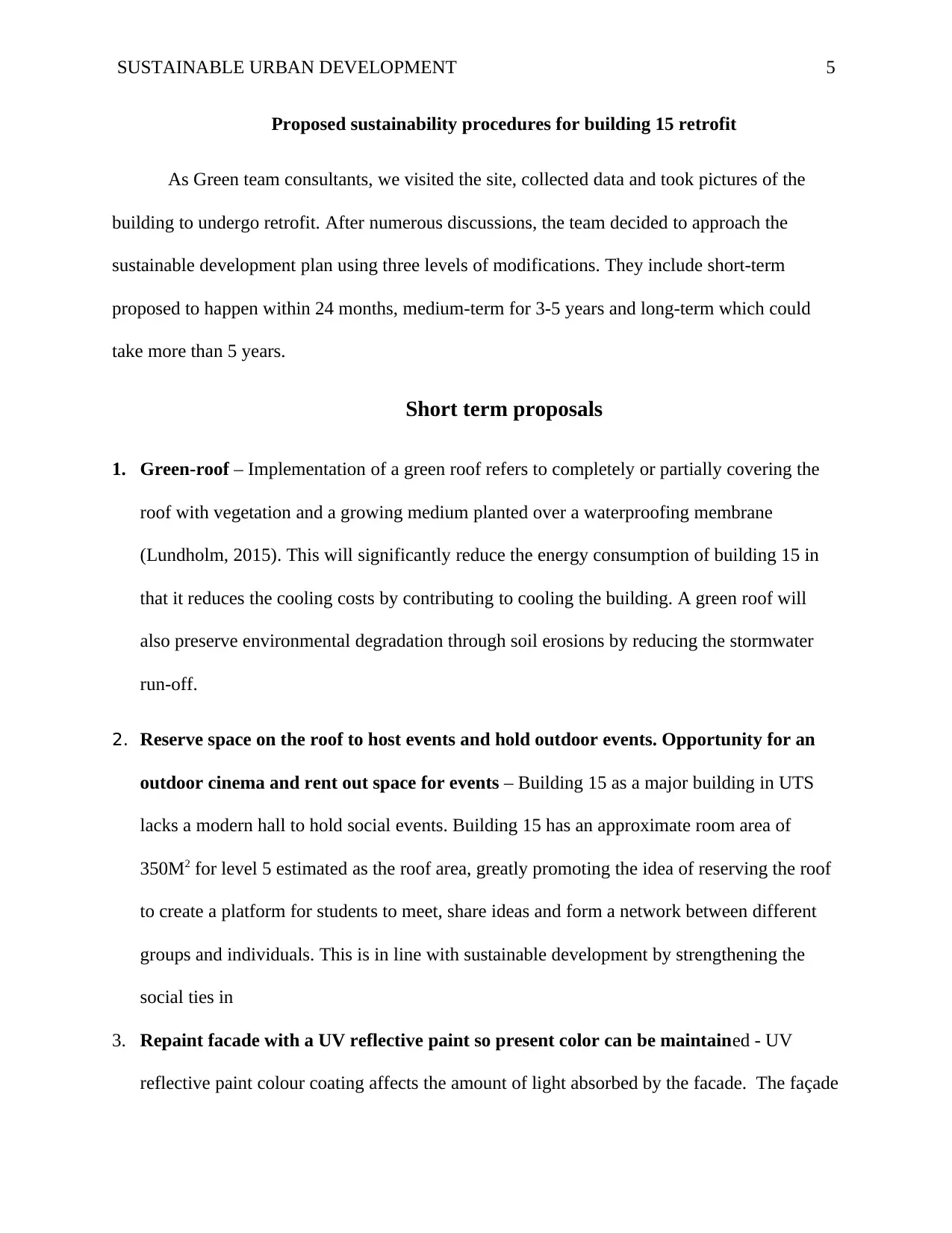
SUSTAINABLE URBAN DEVELOPMENT 5
Proposed sustainability procedures for building 15 retrofit
As Green team consultants, we visited the site, collected data and took pictures of the
building to undergo retrofit. After numerous discussions, the team decided to approach the
sustainable development plan using three levels of modifications. They include short-term
proposed to happen within 24 months, medium-term for 3-5 years and long-term which could
take more than 5 years.
Short term proposals
1. Green-roof – Implementation of a green roof refers to completely or partially covering the
roof with vegetation and a growing medium planted over a waterproofing membrane
(Lundholm, 2015). This will significantly reduce the energy consumption of building 15 in
that it reduces the cooling costs by contributing to cooling the building. A green roof will
also preserve environmental degradation through soil erosions by reducing the stormwater
run-off.
2. Reserve space on the roof to host events and hold outdoor events. Opportunity for an
outdoor cinema and rent out space for events – Building 15 as a major building in UTS
lacks a modern hall to hold social events. Building 15 has an approximate room area of
350M2 for level 5 estimated as the roof area, greatly promoting the idea of reserving the roof
to create a platform for students to meet, share ideas and form a network between different
groups and individuals. This is in line with sustainable development by strengthening the
social ties in
3. Repaint facade with a UV reflective paint so present color can be maintained - UV
reflective paint colour coating affects the amount of light absorbed by the facade. The façade
Proposed sustainability procedures for building 15 retrofit
As Green team consultants, we visited the site, collected data and took pictures of the
building to undergo retrofit. After numerous discussions, the team decided to approach the
sustainable development plan using three levels of modifications. They include short-term
proposed to happen within 24 months, medium-term for 3-5 years and long-term which could
take more than 5 years.
Short term proposals
1. Green-roof – Implementation of a green roof refers to completely or partially covering the
roof with vegetation and a growing medium planted over a waterproofing membrane
(Lundholm, 2015). This will significantly reduce the energy consumption of building 15 in
that it reduces the cooling costs by contributing to cooling the building. A green roof will
also preserve environmental degradation through soil erosions by reducing the stormwater
run-off.
2. Reserve space on the roof to host events and hold outdoor events. Opportunity for an
outdoor cinema and rent out space for events – Building 15 as a major building in UTS
lacks a modern hall to hold social events. Building 15 has an approximate room area of
350M2 for level 5 estimated as the roof area, greatly promoting the idea of reserving the roof
to create a platform for students to meet, share ideas and form a network between different
groups and individuals. This is in line with sustainable development by strengthening the
social ties in
3. Repaint facade with a UV reflective paint so present color can be maintained - UV
reflective paint colour coating affects the amount of light absorbed by the facade. The façade
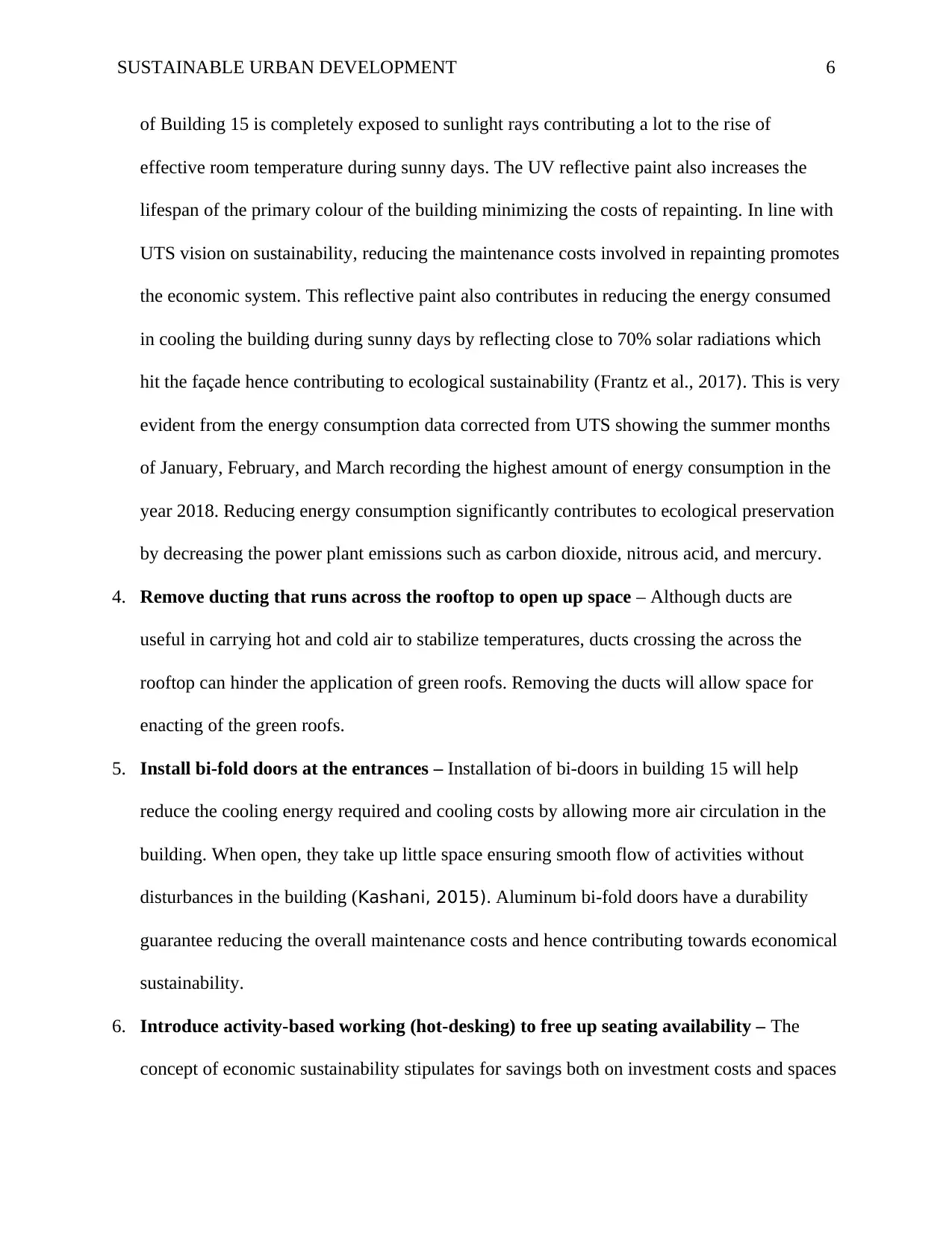
SUSTAINABLE URBAN DEVELOPMENT 6
of Building 15 is completely exposed to sunlight rays contributing a lot to the rise of
effective room temperature during sunny days. The UV reflective paint also increases the
lifespan of the primary colour of the building minimizing the costs of repainting. In line with
UTS vision on sustainability, reducing the maintenance costs involved in repainting promotes
the economic system. This reflective paint also contributes in reducing the energy consumed
in cooling the building during sunny days by reflecting close to 70% solar radiations which
hit the façade hence contributing to ecological sustainability (Frantz et al., 2017). This is very
evident from the energy consumption data corrected from UTS showing the summer months
of January, February, and March recording the highest amount of energy consumption in the
year 2018. Reducing energy consumption significantly contributes to ecological preservation
by decreasing the power plant emissions such as carbon dioxide, nitrous acid, and mercury.
4. Remove ducting that runs across the rooftop to open up space – Although ducts are
useful in carrying hot and cold air to stabilize temperatures, ducts crossing the across the
rooftop can hinder the application of green roofs. Removing the ducts will allow space for
enacting of the green roofs.
5. Install bi-fold doors at the entrances – Installation of bi-doors in building 15 will help
reduce the cooling energy required and cooling costs by allowing more air circulation in the
building. When open, they take up little space ensuring smooth flow of activities without
disturbances in the building (Kashani, 2015). Aluminum bi-fold doors have a durability
guarantee reducing the overall maintenance costs and hence contributing towards economical
sustainability.
6. Introduce activity-based working (hot-desking) to free up seating availability – The
concept of economic sustainability stipulates for savings both on investment costs and spaces
of Building 15 is completely exposed to sunlight rays contributing a lot to the rise of
effective room temperature during sunny days. The UV reflective paint also increases the
lifespan of the primary colour of the building minimizing the costs of repainting. In line with
UTS vision on sustainability, reducing the maintenance costs involved in repainting promotes
the economic system. This reflective paint also contributes in reducing the energy consumed
in cooling the building during sunny days by reflecting close to 70% solar radiations which
hit the façade hence contributing to ecological sustainability (Frantz et al., 2017). This is very
evident from the energy consumption data corrected from UTS showing the summer months
of January, February, and March recording the highest amount of energy consumption in the
year 2018. Reducing energy consumption significantly contributes to ecological preservation
by decreasing the power plant emissions such as carbon dioxide, nitrous acid, and mercury.
4. Remove ducting that runs across the rooftop to open up space – Although ducts are
useful in carrying hot and cold air to stabilize temperatures, ducts crossing the across the
rooftop can hinder the application of green roofs. Removing the ducts will allow space for
enacting of the green roofs.
5. Install bi-fold doors at the entrances – Installation of bi-doors in building 15 will help
reduce the cooling energy required and cooling costs by allowing more air circulation in the
building. When open, they take up little space ensuring smooth flow of activities without
disturbances in the building (Kashani, 2015). Aluminum bi-fold doors have a durability
guarantee reducing the overall maintenance costs and hence contributing towards economical
sustainability.
6. Introduce activity-based working (hot-desking) to free up seating availability – The
concept of economic sustainability stipulates for savings both on investment costs and spaces
⊘ This is a preview!⊘
Do you want full access?
Subscribe today to unlock all pages.

Trusted by 1+ million students worldwide
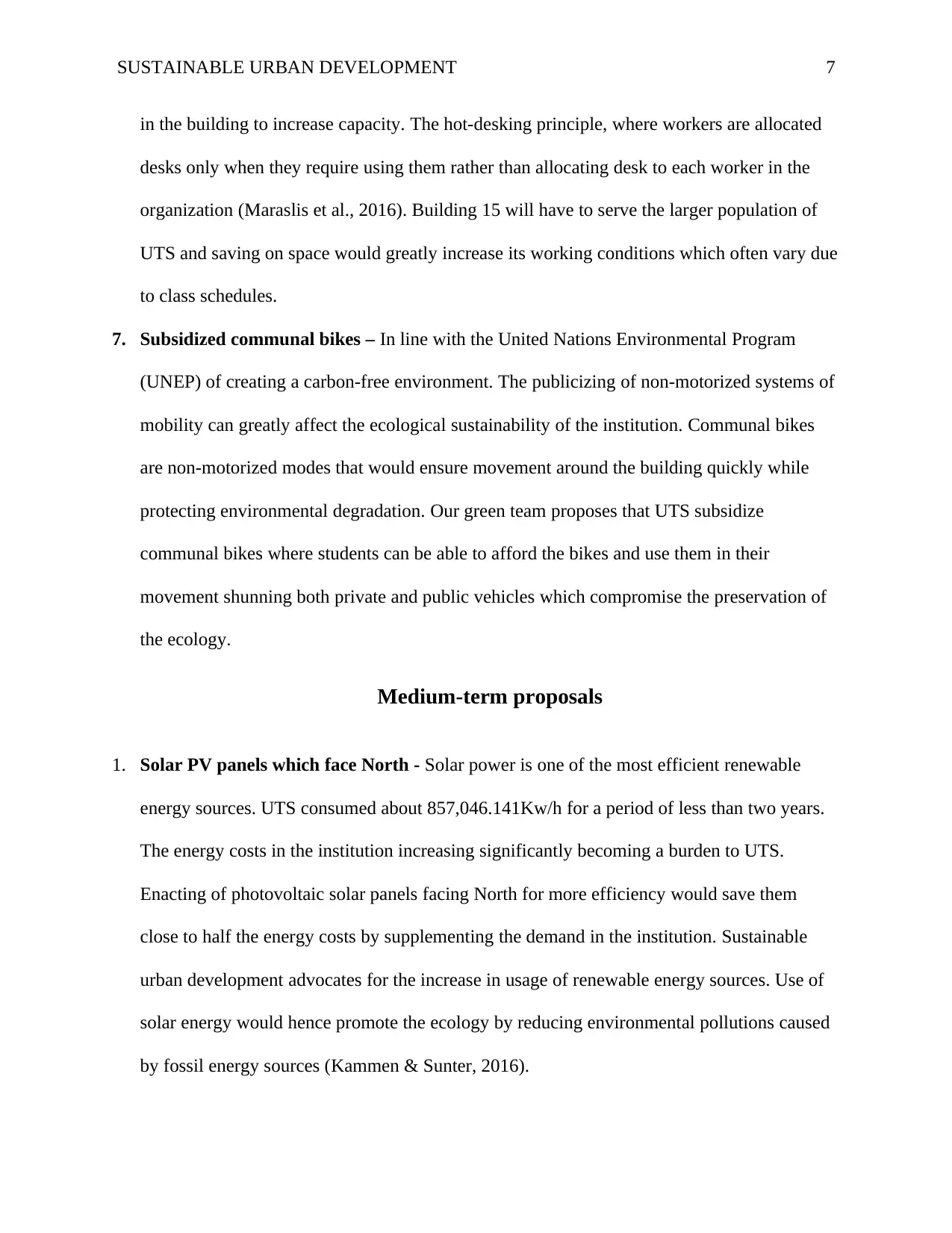
SUSTAINABLE URBAN DEVELOPMENT 7
in the building to increase capacity. The hot-desking principle, where workers are allocated
desks only when they require using them rather than allocating desk to each worker in the
organization (Maraslis et al., 2016). Building 15 will have to serve the larger population of
UTS and saving on space would greatly increase its working conditions which often vary due
to class schedules.
7. Subsidized communal bikes – In line with the United Nations Environmental Program
(UNEP) of creating a carbon-free environment. The publicizing of non-motorized systems of
mobility can greatly affect the ecological sustainability of the institution. Communal bikes
are non-motorized modes that would ensure movement around the building quickly while
protecting environmental degradation. Our green team proposes that UTS subsidize
communal bikes where students can be able to afford the bikes and use them in their
movement shunning both private and public vehicles which compromise the preservation of
the ecology.
Medium-term proposals
1. Solar PV panels which face North - Solar power is one of the most efficient renewable
energy sources. UTS consumed about 857,046.141Kw/h for a period of less than two years.
The energy costs in the institution increasing significantly becoming a burden to UTS.
Enacting of photovoltaic solar panels facing North for more efficiency would save them
close to half the energy costs by supplementing the demand in the institution. Sustainable
urban development advocates for the increase in usage of renewable energy sources. Use of
solar energy would hence promote the ecology by reducing environmental pollutions caused
by fossil energy sources (Kammen & Sunter, 2016).
in the building to increase capacity. The hot-desking principle, where workers are allocated
desks only when they require using them rather than allocating desk to each worker in the
organization (Maraslis et al., 2016). Building 15 will have to serve the larger population of
UTS and saving on space would greatly increase its working conditions which often vary due
to class schedules.
7. Subsidized communal bikes – In line with the United Nations Environmental Program
(UNEP) of creating a carbon-free environment. The publicizing of non-motorized systems of
mobility can greatly affect the ecological sustainability of the institution. Communal bikes
are non-motorized modes that would ensure movement around the building quickly while
protecting environmental degradation. Our green team proposes that UTS subsidize
communal bikes where students can be able to afford the bikes and use them in their
movement shunning both private and public vehicles which compromise the preservation of
the ecology.
Medium-term proposals
1. Solar PV panels which face North - Solar power is one of the most efficient renewable
energy sources. UTS consumed about 857,046.141Kw/h for a period of less than two years.
The energy costs in the institution increasing significantly becoming a burden to UTS.
Enacting of photovoltaic solar panels facing North for more efficiency would save them
close to half the energy costs by supplementing the demand in the institution. Sustainable
urban development advocates for the increase in usage of renewable energy sources. Use of
solar energy would hence promote the ecology by reducing environmental pollutions caused
by fossil energy sources (Kammen & Sunter, 2016).
Paraphrase This Document
Need a fresh take? Get an instant paraphrase of this document with our AI Paraphraser
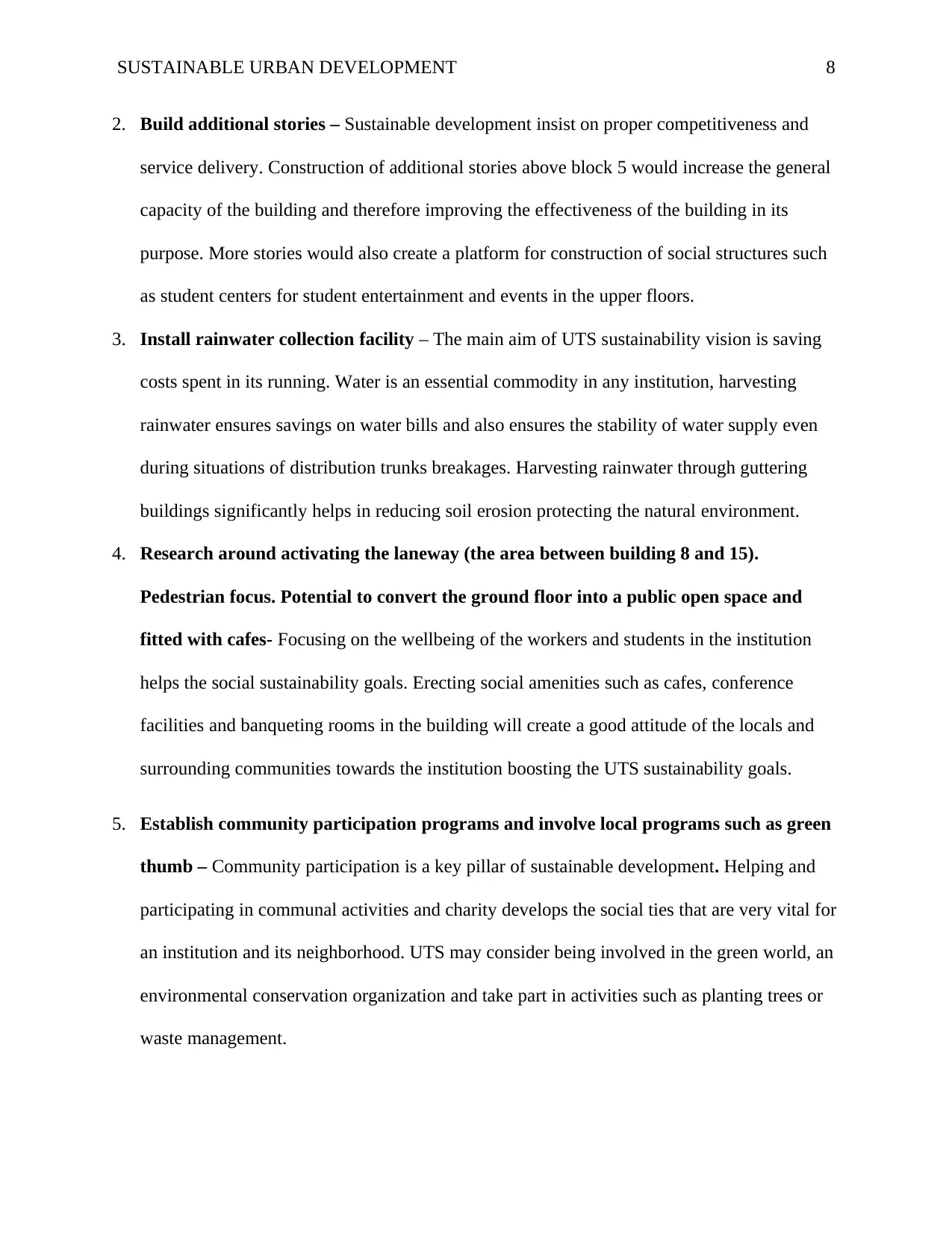
SUSTAINABLE URBAN DEVELOPMENT 8
2. Build additional stories – Sustainable development insist on proper competitiveness and
service delivery. Construction of additional stories above block 5 would increase the general
capacity of the building and therefore improving the effectiveness of the building in its
purpose. More stories would also create a platform for construction of social structures such
as student centers for student entertainment and events in the upper floors.
3. Install rainwater collection facility – The main aim of UTS sustainability vision is saving
costs spent in its running. Water is an essential commodity in any institution, harvesting
rainwater ensures savings on water bills and also ensures the stability of water supply even
during situations of distribution trunks breakages. Harvesting rainwater through guttering
buildings significantly helps in reducing soil erosion protecting the natural environment.
4. Research around activating the laneway (the area between building 8 and 15).
Pedestrian focus. Potential to convert the ground floor into a public open space and
fitted with cafes- Focusing on the wellbeing of the workers and students in the institution
helps the social sustainability goals. Erecting social amenities such as cafes, conference
facilities and banqueting rooms in the building will create a good attitude of the locals and
surrounding communities towards the institution boosting the UTS sustainability goals.
5. Establish community participation programs and involve local programs such as green
thumb – Community participation is a key pillar of sustainable development. Helping and
participating in communal activities and charity develops the social ties that are very vital for
an institution and its neighborhood. UTS may consider being involved in the green world, an
environmental conservation organization and take part in activities such as planting trees or
waste management.
2. Build additional stories – Sustainable development insist on proper competitiveness and
service delivery. Construction of additional stories above block 5 would increase the general
capacity of the building and therefore improving the effectiveness of the building in its
purpose. More stories would also create a platform for construction of social structures such
as student centers for student entertainment and events in the upper floors.
3. Install rainwater collection facility – The main aim of UTS sustainability vision is saving
costs spent in its running. Water is an essential commodity in any institution, harvesting
rainwater ensures savings on water bills and also ensures the stability of water supply even
during situations of distribution trunks breakages. Harvesting rainwater through guttering
buildings significantly helps in reducing soil erosion protecting the natural environment.
4. Research around activating the laneway (the area between building 8 and 15).
Pedestrian focus. Potential to convert the ground floor into a public open space and
fitted with cafes- Focusing on the wellbeing of the workers and students in the institution
helps the social sustainability goals. Erecting social amenities such as cafes, conference
facilities and banqueting rooms in the building will create a good attitude of the locals and
surrounding communities towards the institution boosting the UTS sustainability goals.
5. Establish community participation programs and involve local programs such as green
thumb – Community participation is a key pillar of sustainable development. Helping and
participating in communal activities and charity develops the social ties that are very vital for
an institution and its neighborhood. UTS may consider being involved in the green world, an
environmental conservation organization and take part in activities such as planting trees or
waste management.
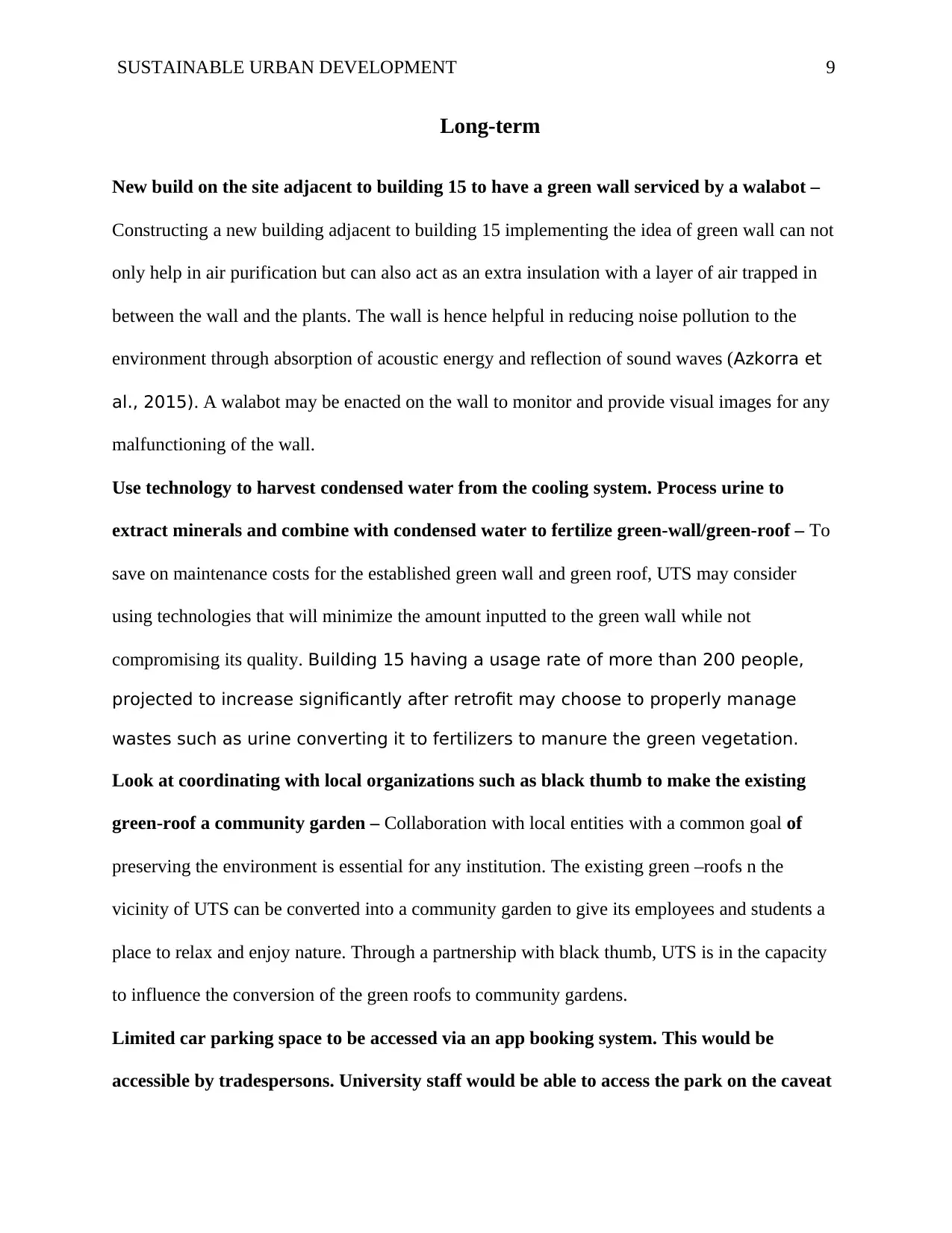
SUSTAINABLE URBAN DEVELOPMENT 9
Long-term
New build on the site adjacent to building 15 to have a green wall serviced by a walabot –
Constructing a new building adjacent to building 15 implementing the idea of green wall can not
only help in air purification but can also act as an extra insulation with a layer of air trapped in
between the wall and the plants. The wall is hence helpful in reducing noise pollution to the
environment through absorption of acoustic energy and reflection of sound waves (Azkorra et
al., 2015). A walabot may be enacted on the wall to monitor and provide visual images for any
malfunctioning of the wall.
Use technology to harvest condensed water from the cooling system. Process urine to
extract minerals and combine with condensed water to fertilize green-wall/green-roof – To
save on maintenance costs for the established green wall and green roof, UTS may consider
using technologies that will minimize the amount inputted to the green wall while not
compromising its quality. Building 15 having a usage rate of more than 200 people,
projected to increase significantly after retrofit may choose to properly manage
wastes such as urine converting it to fertilizers to manure the green vegetation.
Look at coordinating with local organizations such as black thumb to make the existing
green-roof a community garden – Collaboration with local entities with a common goal of
preserving the environment is essential for any institution. The existing green –roofs n the
vicinity of UTS can be converted into a community garden to give its employees and students a
place to relax and enjoy nature. Through a partnership with black thumb, UTS is in the capacity
to influence the conversion of the green roofs to community gardens.
Limited car parking space to be accessed via an app booking system. This would be
accessible by tradespersons. University staff would be able to access the park on the caveat
Long-term
New build on the site adjacent to building 15 to have a green wall serviced by a walabot –
Constructing a new building adjacent to building 15 implementing the idea of green wall can not
only help in air purification but can also act as an extra insulation with a layer of air trapped in
between the wall and the plants. The wall is hence helpful in reducing noise pollution to the
environment through absorption of acoustic energy and reflection of sound waves (Azkorra et
al., 2015). A walabot may be enacted on the wall to monitor and provide visual images for any
malfunctioning of the wall.
Use technology to harvest condensed water from the cooling system. Process urine to
extract minerals and combine with condensed water to fertilize green-wall/green-roof – To
save on maintenance costs for the established green wall and green roof, UTS may consider
using technologies that will minimize the amount inputted to the green wall while not
compromising its quality. Building 15 having a usage rate of more than 200 people,
projected to increase significantly after retrofit may choose to properly manage
wastes such as urine converting it to fertilizers to manure the green vegetation.
Look at coordinating with local organizations such as black thumb to make the existing
green-roof a community garden – Collaboration with local entities with a common goal of
preserving the environment is essential for any institution. The existing green –roofs n the
vicinity of UTS can be converted into a community garden to give its employees and students a
place to relax and enjoy nature. Through a partnership with black thumb, UTS is in the capacity
to influence the conversion of the green roofs to community gardens.
Limited car parking space to be accessed via an app booking system. This would be
accessible by tradespersons. University staff would be able to access the park on the caveat
⊘ This is a preview!⊘
Do you want full access?
Subscribe today to unlock all pages.

Trusted by 1+ million students worldwide
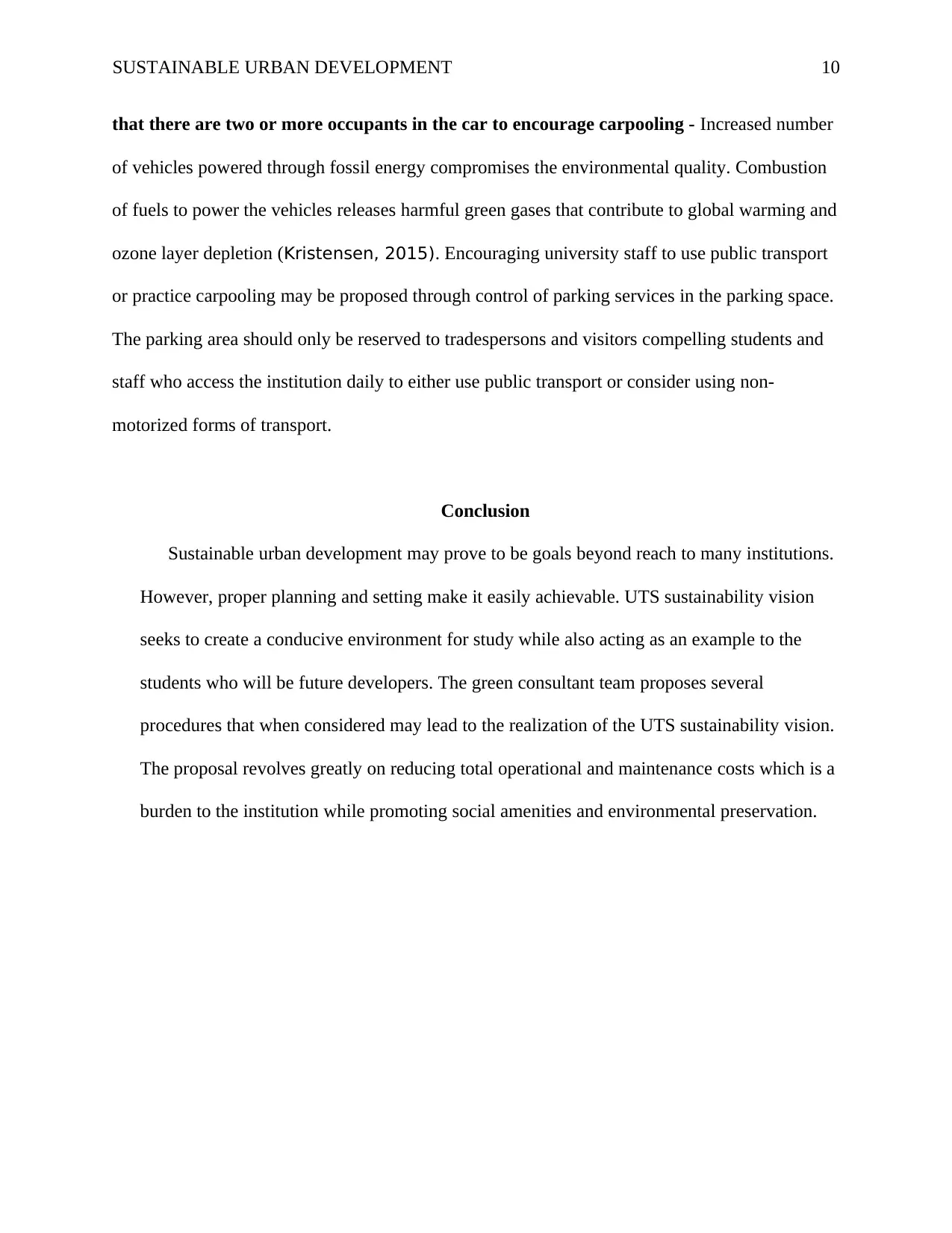
SUSTAINABLE URBAN DEVELOPMENT 10
that there are two or more occupants in the car to encourage carpooling - Increased number
of vehicles powered through fossil energy compromises the environmental quality. Combustion
of fuels to power the vehicles releases harmful green gases that contribute to global warming and
ozone layer depletion (Kristensen, 2015). Encouraging university staff to use public transport
or practice carpooling may be proposed through control of parking services in the parking space.
The parking area should only be reserved to tradespersons and visitors compelling students and
staff who access the institution daily to either use public transport or consider using non-
motorized forms of transport.
Conclusion
Sustainable urban development may prove to be goals beyond reach to many institutions.
However, proper planning and setting make it easily achievable. UTS sustainability vision
seeks to create a conducive environment for study while also acting as an example to the
students who will be future developers. The green consultant team proposes several
procedures that when considered may lead to the realization of the UTS sustainability vision.
The proposal revolves greatly on reducing total operational and maintenance costs which is a
burden to the institution while promoting social amenities and environmental preservation.
that there are two or more occupants in the car to encourage carpooling - Increased number
of vehicles powered through fossil energy compromises the environmental quality. Combustion
of fuels to power the vehicles releases harmful green gases that contribute to global warming and
ozone layer depletion (Kristensen, 2015). Encouraging university staff to use public transport
or practice carpooling may be proposed through control of parking services in the parking space.
The parking area should only be reserved to tradespersons and visitors compelling students and
staff who access the institution daily to either use public transport or consider using non-
motorized forms of transport.
Conclusion
Sustainable urban development may prove to be goals beyond reach to many institutions.
However, proper planning and setting make it easily achievable. UTS sustainability vision
seeks to create a conducive environment for study while also acting as an example to the
students who will be future developers. The green consultant team proposes several
procedures that when considered may lead to the realization of the UTS sustainability vision.
The proposal revolves greatly on reducing total operational and maintenance costs which is a
burden to the institution while promoting social amenities and environmental preservation.
Paraphrase This Document
Need a fresh take? Get an instant paraphrase of this document with our AI Paraphraser
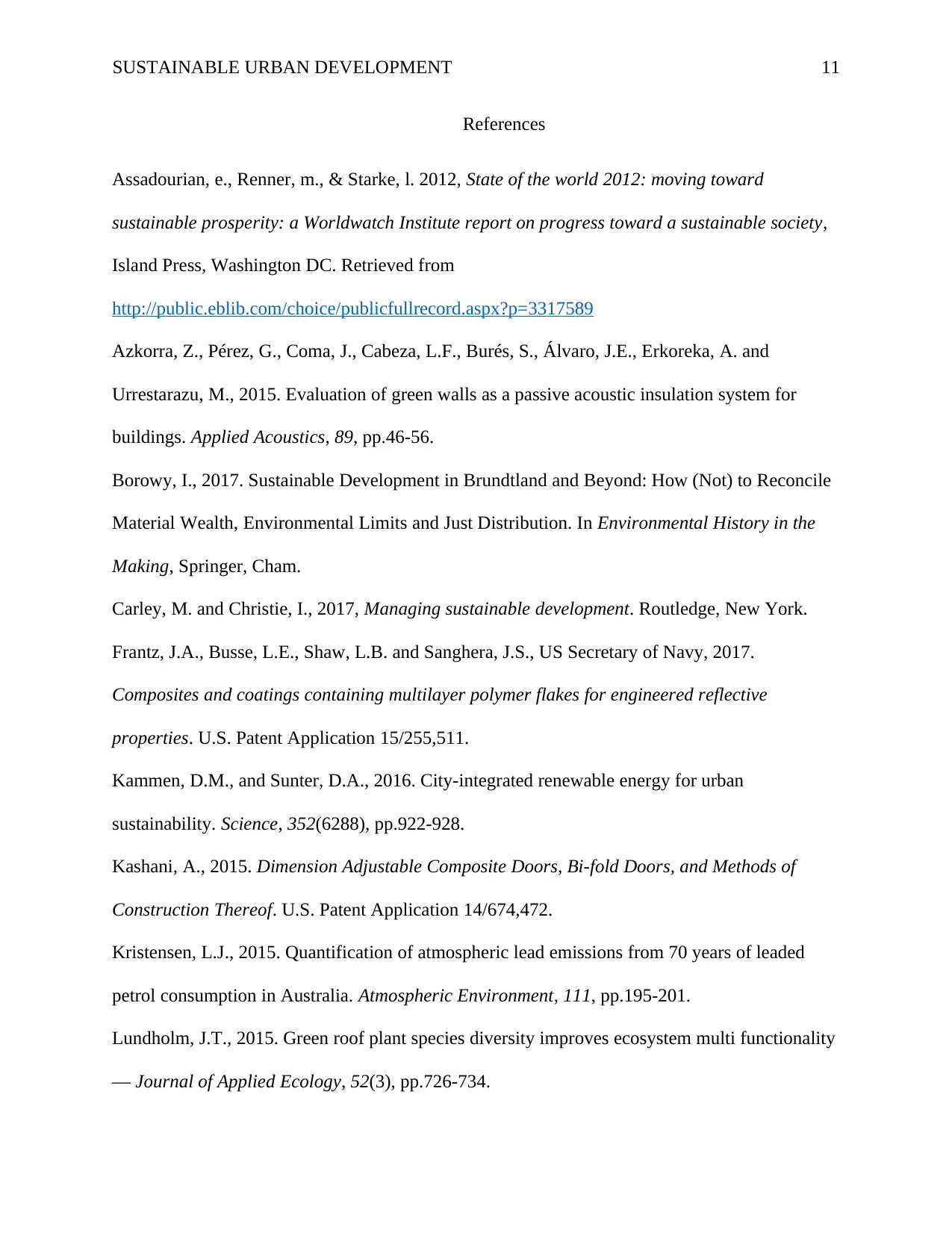
SUSTAINABLE URBAN DEVELOPMENT 11
References
Assadourian, e., Renner, m., & Starke, l. 2012, State of the world 2012: moving toward
sustainable prosperity: a Worldwatch Institute report on progress toward a sustainable society,
Island Press, Washington DC. Retrieved from
http://public.eblib.com/choice/publicfullrecord.aspx?p=3317589
Azkorra, Z., Pérez, G., Coma, J., Cabeza, L.F., Burés, S., Álvaro, J.E., Erkoreka, A. and
Urrestarazu, M., 2015. Evaluation of green walls as a passive acoustic insulation system for
buildings. Applied Acoustics, 89, pp.46-56.
Borowy, I., 2017. Sustainable Development in Brundtland and Beyond: How (Not) to Reconcile
Material Wealth, Environmental Limits and Just Distribution. In Environmental History in the
Making, Springer, Cham.
Carley, M. and Christie, I., 2017, Managing sustainable development. Routledge, New York.
Frantz, J.A., Busse, L.E., Shaw, L.B. and Sanghera, J.S., US Secretary of Navy, 2017.
Composites and coatings containing multilayer polymer flakes for engineered reflective
properties. U.S. Patent Application 15/255,511.
Kammen, D.M., and Sunter, D.A., 2016. City-integrated renewable energy for urban
sustainability. Science, 352(6288), pp.922-928.
Kashani, A., 2015. Dimension Adjustable Composite Doors, Bi-fold Doors, and Methods of
Construction Thereof. U.S. Patent Application 14/674,472.
Kristensen, L.J., 2015. Quantification of atmospheric lead emissions from 70 years of leaded
petrol consumption in Australia. Atmospheric Environment, 111, pp.195-201.
Lundholm, J.T., 2015. Green roof plant species diversity improves ecosystem multi functionality
— Journal of Applied Ecology, 52(3), pp.726-734.
References
Assadourian, e., Renner, m., & Starke, l. 2012, State of the world 2012: moving toward
sustainable prosperity: a Worldwatch Institute report on progress toward a sustainable society,
Island Press, Washington DC. Retrieved from
http://public.eblib.com/choice/publicfullrecord.aspx?p=3317589
Azkorra, Z., Pérez, G., Coma, J., Cabeza, L.F., Burés, S., Álvaro, J.E., Erkoreka, A. and
Urrestarazu, M., 2015. Evaluation of green walls as a passive acoustic insulation system for
buildings. Applied Acoustics, 89, pp.46-56.
Borowy, I., 2017. Sustainable Development in Brundtland and Beyond: How (Not) to Reconcile
Material Wealth, Environmental Limits and Just Distribution. In Environmental History in the
Making, Springer, Cham.
Carley, M. and Christie, I., 2017, Managing sustainable development. Routledge, New York.
Frantz, J.A., Busse, L.E., Shaw, L.B. and Sanghera, J.S., US Secretary of Navy, 2017.
Composites and coatings containing multilayer polymer flakes for engineered reflective
properties. U.S. Patent Application 15/255,511.
Kammen, D.M., and Sunter, D.A., 2016. City-integrated renewable energy for urban
sustainability. Science, 352(6288), pp.922-928.
Kashani, A., 2015. Dimension Adjustable Composite Doors, Bi-fold Doors, and Methods of
Construction Thereof. U.S. Patent Application 14/674,472.
Kristensen, L.J., 2015. Quantification of atmospheric lead emissions from 70 years of leaded
petrol consumption in Australia. Atmospheric Environment, 111, pp.195-201.
Lundholm, J.T., 2015. Green roof plant species diversity improves ecosystem multi functionality
— Journal of Applied Ecology, 52(3), pp.726-734.
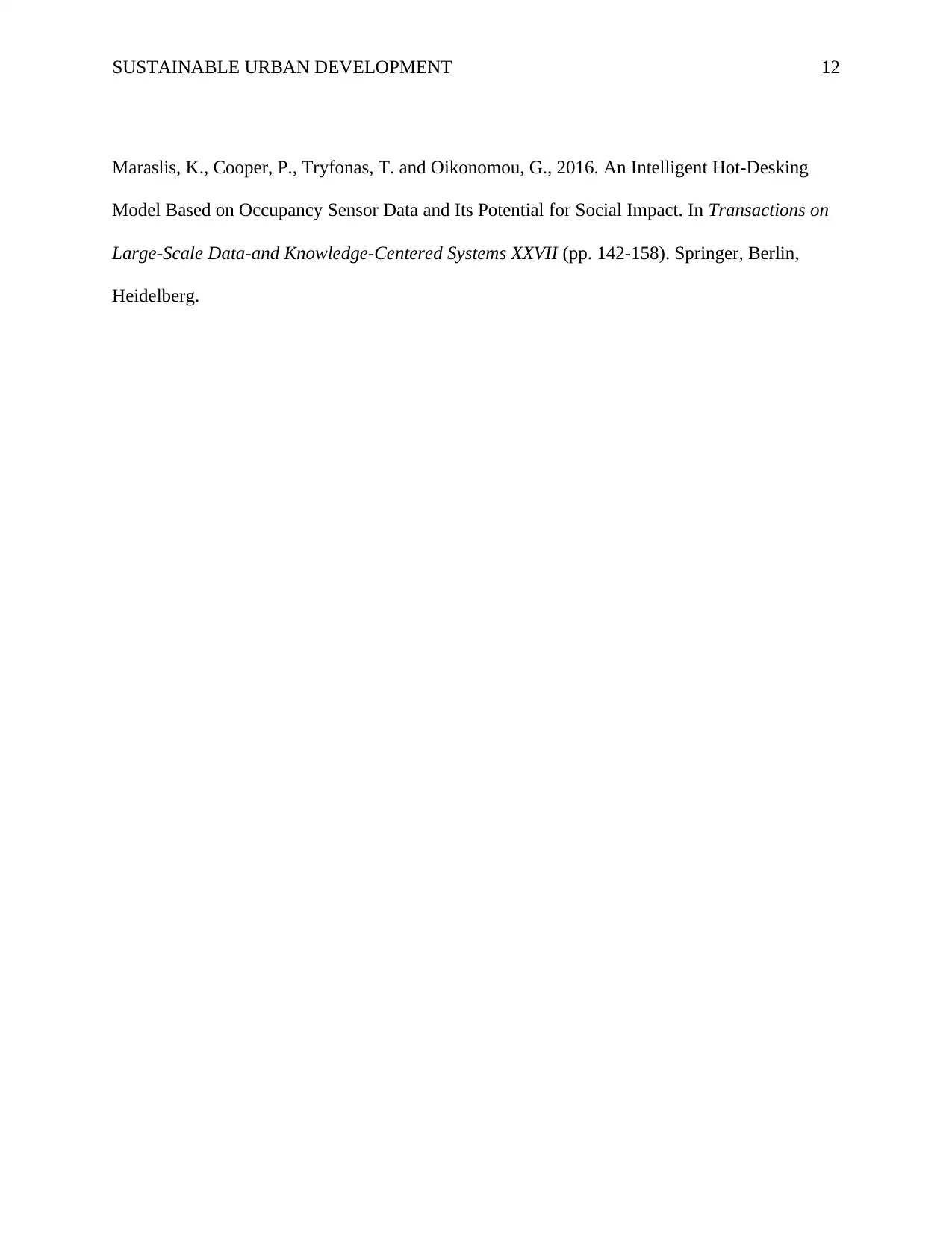
SUSTAINABLE URBAN DEVELOPMENT 12
Maraslis, K., Cooper, P., Tryfonas, T. and Oikonomou, G., 2016. An Intelligent Hot-Desking
Model Based on Occupancy Sensor Data and Its Potential for Social Impact. In Transactions on
Large-Scale Data-and Knowledge-Centered Systems XXVII (pp. 142-158). Springer, Berlin,
Heidelberg.
Maraslis, K., Cooper, P., Tryfonas, T. and Oikonomou, G., 2016. An Intelligent Hot-Desking
Model Based on Occupancy Sensor Data and Its Potential for Social Impact. In Transactions on
Large-Scale Data-and Knowledge-Centered Systems XXVII (pp. 142-158). Springer, Berlin,
Heidelberg.
⊘ This is a preview!⊘
Do you want full access?
Subscribe today to unlock all pages.

Trusted by 1+ million students worldwide
1 out of 12
Related Documents
Your All-in-One AI-Powered Toolkit for Academic Success.
+13062052269
info@desklib.com
Available 24*7 on WhatsApp / Email
![[object Object]](/_next/static/media/star-bottom.7253800d.svg)
Unlock your academic potential
Copyright © 2020–2025 A2Z Services. All Rights Reserved. Developed and managed by ZUCOL.





